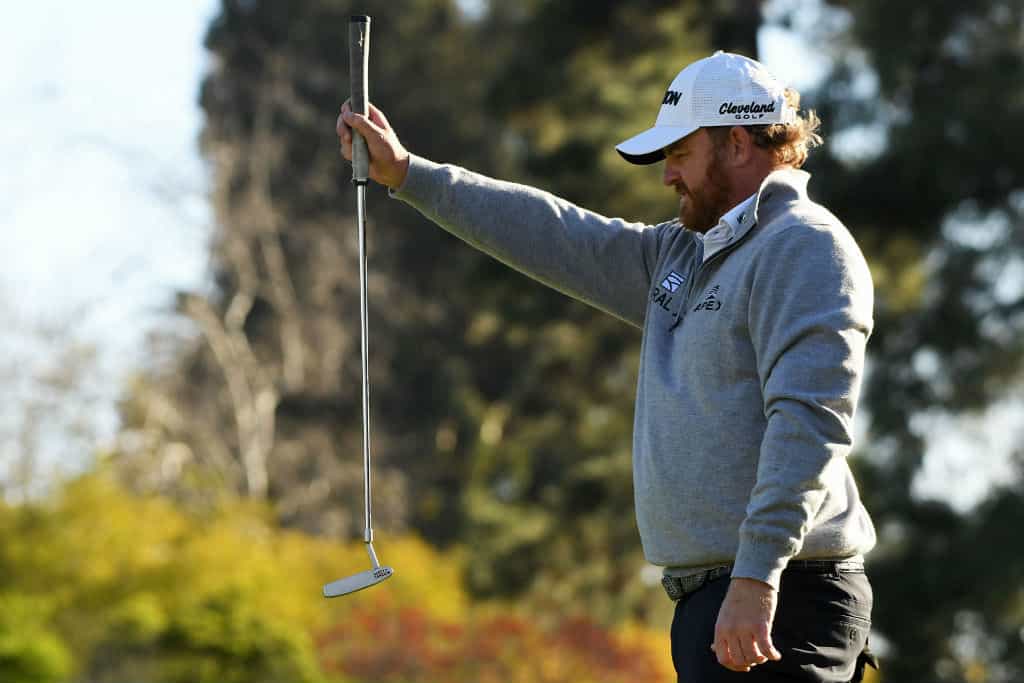
Sorry Adam, but the long putter has got to go
This should be a story about a great comeback. About a former World No. 1 recapturing old glories to once again stand near the summit at a major championship.
That should be the focus of Adam Scott’s remarkable PGA Championship revival.
The man with the smoothest swing in golf has spent much of the last two years trawling the lower reaches of leaderboards.
He arrived at Bellerive 76th in the world rankings.
In a week marked by sorrow, following the death of his good friend Jarrod Lyle, Scott’s uplifting performance should have been a welcome ray of light for Australian golf.
But we’re not talking about that. This, instead, is a story about a putter.
Whether or not Scott is anchoring his long putter against his chest – and I don’t for a moment think he is – is almost immaterial.
It’s the mere perception that he COULD be, and that there’s nothing that can be done about it, that is seriously damaging the game.
What are the rules around anchoring?
I sat in an England Golf rules meeting two years as the new anchoring laws were spelled out to championship referees.
Rule 14-1b banned the anchoring of the club – either directly, when a player “intentionally holds the club or a gripping hand in contact with any part of his body”, or by the use of an anchor point.
That is deemed to be “when the player intentionally holds a forearm in contact with any part of his body to establish a gripping hand as a stable point around which the other hand may swing the club”.
Bizarrely, though, given the years of R&A and USGA hand-wringing and the controversies that had got them to this point, the new rule didn’t ban either the long or the belly putter.
So the implements that had actually been the cause of much of the outcry were still permitted.
There were lots of infographics showing what was and wasn’t allowed – pictures of putters held away from the chest and various other parts of the body.
But it only took one raised hand for the illusion to come crashing down.
How can anchoring be policed?
What, mused one experienced official, could be done if there was a suspicion of anchoring but it wasn’t clear cut?
Say a player was using a long putter in rainy conditions. They were wearing waterproofs and it appeared they were anchoring the putter to their chest.
How could that be proved? Was the putter simply touching the clothing – which isn’t a breach of the rules?
How could you actually tell if it was anchoring? How could you accurately assess whether a penalty was required?
The answer, as we understood it, was to rely on player integrity. Basically, if you said you weren’t anchoring that was good enough for everyone unless there was concrete evidence to the contrary.
That’s because the act of anchoring, as defined in the rules, has to be intentional.
But like the silly form you fill in when you are going to a foreign country that asks you whether you are a terrorist, who is going to admit to anchoring?
And so we have this atmosphere of rancour each time a player who uses a long putter gets into contention – or employs a technique that bears the slightest suggestion that their stroke could be anchored.
Bernhard Langer, a player whose middle name could be ‘honesty’, has been fending off criticisms and accusations ever since the new rules came into effect because he uses a broom-handle.
The backlash against Scott grew with every birdie in the final round at Bellerive. Can you imagine the outcry if he’d actually won?
It would have been a victory that came with a big asterisk for many of those watching at home. Just look at social media.
Let’s not kid ourselves, though, that day is coming.
What is the solution to end the debate around perceived anchoring?
The Aussie isn’t doing anything that is against the rules. He is following them to the letter.
But those rules are wrong. All they have done is promote suspicion among both players and spectators alike.
Perceptions are hugely important and any suggestion of wrongdoing – whether valid or otherwise – is hurting the sport.
So it’s time for rules makers to act, do what they should have in the first place and set concrete guidelines on putter lengths.
Sorry Adam, but the long putter has got to go.

Fox on fire in fused format and finally top dog on European Tour

What do the Rules of Golf say about slow play?

Should Holmes be allowed to get away with his antics at Riviera?
Steve Carroll

A journalist for 25 years, Steve has been immersed in club golf for almost as long. A former club captain, he has passed the Level 3 Rules of Golf exam with distinction having attended the R&A's prestigious Tournament Administrators and Referees Seminar.
Steve has officiated at a host of high-profile tournaments, including Open Regional Qualifying, PGA Fourball Championship, English Men's Senior Amateur, and the North of England Amateur Championship. In 2023, he made his international debut as part of the team that refereed England vs Switzerland U16 girls.
A part of NCG's Top 100s panel, Steve has a particular love of links golf and is frantically trying to restore his single-figure handicap. He currently floats at around 11.
Steve plays at Close House, in Newcastle, and York GC, where he is a member of the club's matches and competitions committee and referees the annual 36-hole scratch York Rose Bowl.
Having studied history at Newcastle University, he became a journalist having passed his NTCJ exams at Darlington College of Technology.
What's in Steve's bag: TaylorMade Stealth 2 driver, 3-wood, and hybrids; TaylorMade Stealth 2 irons; TaylorMade Hi-Toe, Ping ChipR, Sik Putter.












